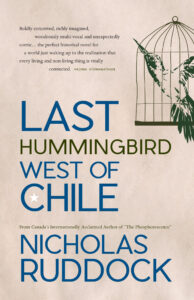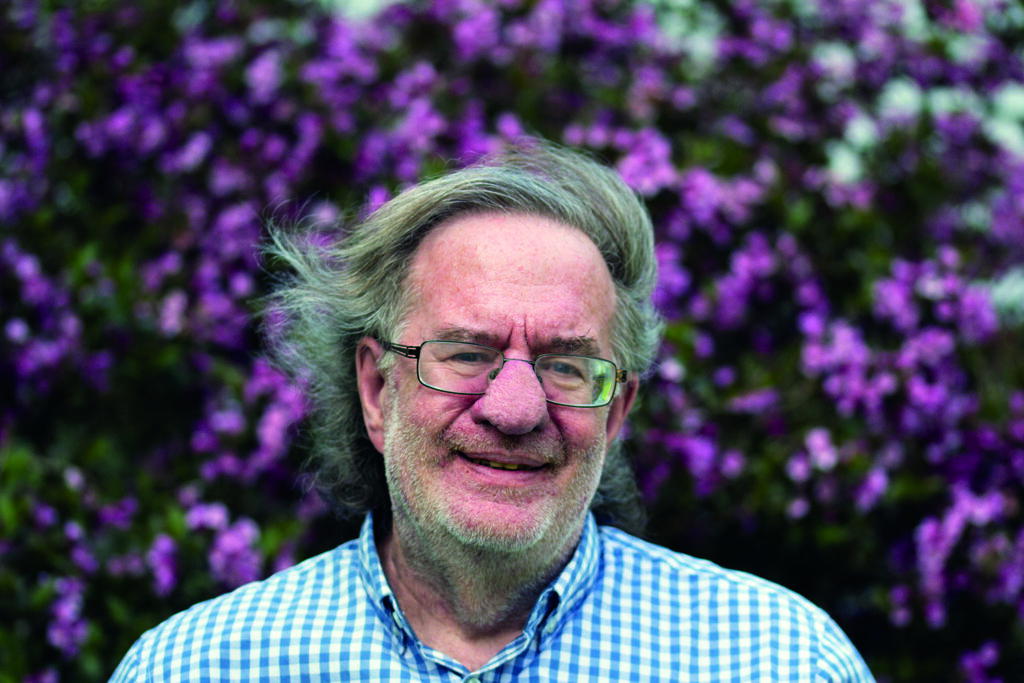Nicholas Ruddock: “Thinking like a hummingbird seemed easy”
October 2021
Can you tell us a little about yourself? And what’s your connection to NL?
I live in Guelph, Ontario. I have been married to the artist, Cheryl Ruddock, for 45 years. We have four children.
In 1969 I graduated from the University of Toronto Medical School. I then decided to cast that training aside and attempt a career at writing. For sustenance, I worked for six months at a button factory on Spadina Avenue, manually attaching pink and blue buttons to cardboard plaques. As for the writing, I found I had nothing of any value to say. Sanity soon prevailed. In May of 1970 I applied for an internship at the St John’s General Hospital, to the new Faculty of Medicine at MUN. All my friends had gone west; I headed east and there I was on Signal Hill on a high clear and windy day, feeling downtown Toronto blow away like a balloon. I became hooked on the weather, the language, the humour. I have written about this already in several articles for NQ. In St John’s, I lived first in the Nurses’ Residence on Forest Rd, then on Fitzpatrick Avenue, then on Rennies Mill Road. In 1971, at last fully qualified, I took a position on the South Coast, in Belleoram, Fortune Bay, as District Medical Officer. This was before the Bay d’Espoir Road was punched through, so some of the local travel was by boat. Being incompetent in self-care, I was more or less adopted by Tom and Martha Keeping, and so came to have a very intense experience in outport life, death, birth, fog, and music. Two years later, while in Toronto, I met my wife and we moved to the Yukon Territory and then to Montreal (McGill, Anaesthesia) before settling in Guelph. Annually, we have returned to Newfoundland for the hiking and the trad music scene, wherever that may be at the moment. We are lifetime members of the East Coast Trail.

Where did the idea for Last Hummingbird West of Chile come from?
A ruby-throated hummingbird became stuck in our porch screen, beak first. Cheryl nudged it out with a fingertip, and the bird then buzzed wildly in semicircles for ten minutes. Furious with us or grateful, we did not know. The next morning I had an image of a three-masted sailing vessel abandoned in the Doldrums, entirely encrusted by migratory hummingbirds, resting. This was the genesis of the novel.
What about the structure. – did you know from the start that there would be so many characters speaking in first person perspective, or did that emerge as you went along?
The hummingbird was the first speaker. A servant girl came second. I did not plan to have multiplevoices, but it soon became clear that if hummingbirds could speak in perfect English, so should a tree, a reef, a scorpion. As the novel progresses, however, the human voices start to dominate, as of course they have in our world since.
And about those different voices, how did that format unfold? For example, did you write the whole narrative through the eyes of one character, then shift to another? What about the challenges of including non-human selves – how do you think like a hummingbird?
I wrote the book in chronological order, choosing speakers as they appeared, naturally. I did not follow a rigid plan, other than to keep the plot moving forward at a good clip. If the next section demanded a human, so be it. If a boar or a donkey, so be it. Ever forward. Thinking like a hummingbird seemed easy, for they are obviously aggressive and opinionated and tough and nonforgiving.
Why set the story in this time? How did you immerse yourself in the mindset and details of the period?
As I mentioned above, the first vision was of a three-masted sailing ship. That pretty much settled the period into the 1850s or earlier. And wooden ships are made of trees, which had to be cut down, and the particular tree cut down (“Quercus Alba”) developed such a distinctive and political voice that I was never tempted to move from the nineteenth century. It wasn’t necessary, because the novel became hypermodern by its style/content. Although the seeds of colonialism were sown long before this book begins, the evil fruits were ripe for literary picking.
It’s not unheard of for doctors to write, although where they find the time I don’t know. Was it always an activity you turned to? Were you always planning to focus on it as you were less occupied by your medical practice?
I never stopped reading, reading, reading. At one point I thought I had read every novel published in Canada, and the best ones from everywhere else. I also kept a diary of poems about family life. But I never thought of publication until the children were at university, and we began to share sentences we liked from Naipaul, Joyce, Beckett, Sebald. I began to write my own sentences, based on my outport life in Belleoram, and they were immediately received as poetry in magazines. Breakwater became my publisher. Medical practice only helps a writer, so humbling it is.
What do you like to read? How about music you listen to, or films you watch?
Novels, short stories, poetry, I still read them all. Traditional Newfoundland Music (even “Aunt Martha’s Sheep”), GBS, Con O’Brien, Ryan’s Fancy, Matthew Byrne, The Once, plus Irish Music, plus classical. When actually writing, I listen to the radio, French stations so I am not distracted by words. Films: pretty hard to watch Netflix these days, but we used to go (pre-Covid) to the small cinemas for the European fare, and those were great. I like movies without soundtracks. One of my St John’s stories, [“How Eunice Got Her Baby”] set on Long’s Hill, was filmed by the Canadian Film Centre, narrated by Gordon Pinsent, directed by Ana Valine. It showed at the Nickle Festival, starring Kate Corbett from Holyrood, lasted thirteen minutes, and rumour at the time suggested that it was dropped lower in the program because of its salacious content. But the story itself, pre-film, was sweet and touching.
Last Hummingbird West of Chile ($22.95), Ruddock’s third novel, is now available from Breakwater Books; he has also published a collection of short stories.



